Intermediate Strategies (continued)
Tutorials 1
1. Basic game strategies: there are five main strategies you can follow in a game: racing, priming, holding, blitz and back games. Sometimes one dice roll is enough to completely change your game plan. You "race" when you are ahead in pip count for example. If your opponent is trying to race past, a priming strategy is suggested. If he’s playing a holding game, try to race past and so forth. Don’t try to build primes, for example, if you have built on your two point.
Example 1: This position shows a holding (red) vs prime game. White has a good anchor on his opponent’s golden point (5th point in board) and has a semi-prime position. Red has no option but to build his home board whilst waiting for white to leave a blot.
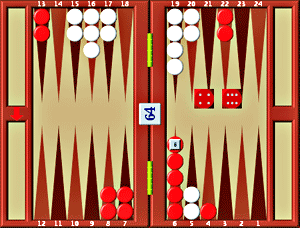
Example 2: In this next example, white is playing a prime vs an attempted backgame. Unfortunately for red, his timing is very poor and he is likely to have to ‘crunch’ his homeboard before white runs into problems bearing his checkers off. Moreover, a 2,4 backgame is nowhere near as valuable as a 2,3 backgame.
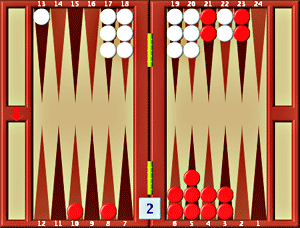
-
2. Points matches: it is important to know the difference between a gammon-go and a gammon-save. Your move choice can vary greatly depending on whether you need to save or make a gammon. Try for a blitzing strategy if you need a gammon. A gammon you should know is worth two points (or four if doubled).
Example: Here’s the (positive) result of red going for a gammon go. He has pushed hard at the beginning of the game to build up his homeboard and had two pieces sent to the bar but the net result is looking positive, especially with a d4 to play.
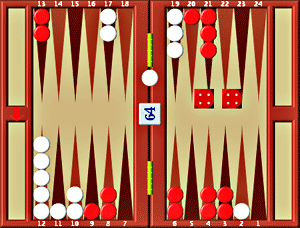
-
3. Direct shots: if you are forced to leave a direct shot, put your checkers where they will be most useful if your opponent misses.
Example: White threw a 6-2 after red’s opening 5-4. 6-2 is a poor first roll but has been put to good use in this case as an attempt to control the golden point.
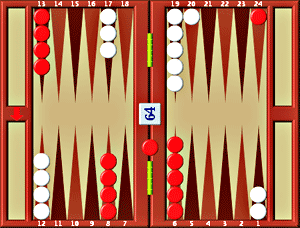
-
4. Multiple shots: if your opponent could hit you on two points, try to leave them the same number of pips away from danger so that the opponent’s dice rolls to hit are limited.
Example: In this next example, you are ‘under the gun’ from white’s pieces if you play bar/23 - 8/3. The best move here is bar/20, 9/7 as it duplicates his three roll from the 4 and 17 points.
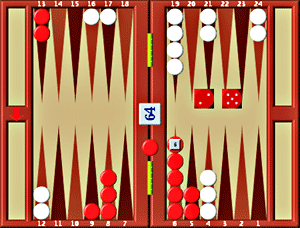
-
5. Advantaged/disadvantaged positions: if you are significantly behind, don't be afraid to leave shots. Be bold. If you are ahead, err on the side of caution.
Example: Here, red is more than 20 points behind in the game and so a bar/24, 8/3 move is recommended as opposed to a more cautious bar/20, 2/1.
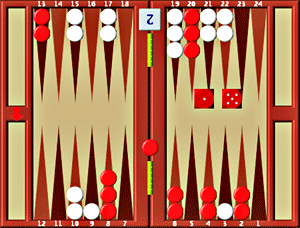
-
6. Advantaged/disadvantaged positions: if you are ahead in a match, run your back pieces; if you are behind, don’t!
Example: Here the best move is 20/13 as you are ahead in the pipcount (as opposed to 13/11, 13/8).
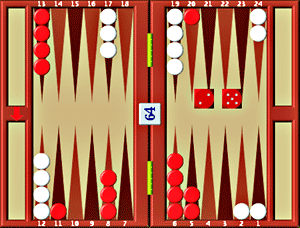
-
7. Being hit: sometimes being hit will improve your timing, allowing you to maintain your board for longer or establish a useful anchor.
Example: In this next example, you have a good defensive backgame but you could either ruin this or your homeboard very soon. The best move is 18/14, 6/3 in the hope that your opponent hits one of your pieces.
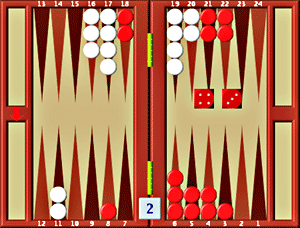
-
8. When to hit: it is usually better to hit a checker on the opponent's side of the board than make a point on your own side.
Example: In this example, 24/14 is the better move, because it damages your opponent's pipcount more than 8/2, 6/2. You might try the latter, however, if you were far behind in a match and in need of a gammon.
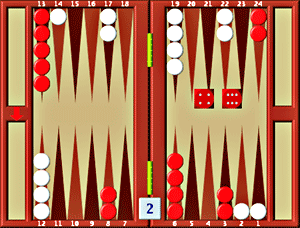
-
9. Opening moves: it is vital to learn the best opening moves for any dice roll.
-
10. Pipcount: pay attention to the pipcount: sometimes when you feel like you’re behind in a game, you may find the pipcount says otherwise!
Example: in this next example, you have been playing a backgame with anchor for sometime but the double five roll effectively turns it into a racing game because of the similarity on pipcount. Run your back checkers.
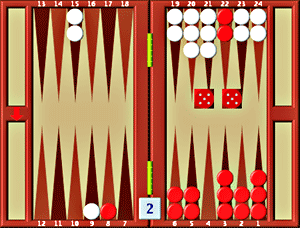
-
11. Planning: always have a plan: whether it’s to run, avoid being gammoned, to gammon someone, play a defensive game or to blockade them etc. But be flexible so that your game plan can change from one dice throw to the next.
Example: in this example, red had a good anchor and was playing a building game. The 4/1 dice roll, however, means he faces a choice of continuing to build or attempting to place white’s pieces on the bar. He has a choice of playing safe (as he’s ahead) or of putting two checkers on the bar. If he were well ahead in points, he might look to play safe but there are a number of reasons why he would choose 6/5 5/1: there is a chance of a gammon despite white’s anchor and he does not want to face a strong backgame with white having several pieces in his homeboard.
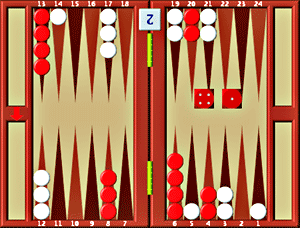
-
12. Match advantage: if you’re several points ahead in a match, e.g 6-1 up in a seven pointer, play it safe!
Example: if the score is say around 6-1 in a seven point match, forget the gammon or the blitz and play safe. 10/3 is your best move.
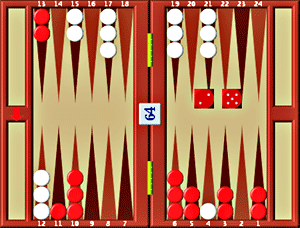
-
13. Play the Bots: try playing our ProBot player to learn from its choice of moves - he plays at an expert level and will rarely make incorrect moves.
-
14. Spacing pieces: try to space out your pieces to give you more flexibility in your choice of moves.
Example: in this case you should do the 13/11(2) and 6/4(2) move as there is no threat currently to your back checkers. If white’s opening roll had been 3-1, you would be advised to move 24/22(2) and 6/4(2) thus preempting any prime/blitz situation and also building your board, making it more tricky for white to play boldly.
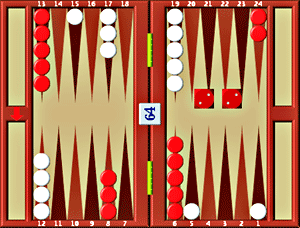
-
15. Crawford Rule: if the Crawford rule is no longer in place and you are trailing, double before your first dice roll.
Example: at 2-0 down in a three-point match, you won the last game now making it 2-1 with Crawford no longer in effect. White will win the game regardless here so double at your first opportunity.
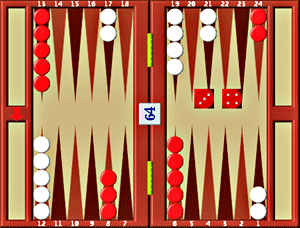
-
16. Pick your best move: don’t just play the move which feels right now, plan your game so that it will look and feel good in a couple of moves time.
Previous Page: Overview










